Shuni-e (Ceremony of the Second Month) at Nigatsu-do
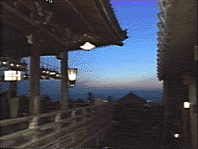 Shuni-e (Ceremony of the Second Month) implies that Buddhist priests may repent sins of profane world, intensify their piety through tough exercise, and pray to the eleven-headed Kannon-image enshrined in the Nigatsu-do for nation's prosterity and world peace.
Shuni-e (Ceremony of the Second Month) implies that Buddhist priests may repent sins of profane world, intensify their piety through tough exercise, and pray to the eleven-headed Kannon-image enshrined in the Nigatsu-do for nation's prosterity and world peace.
Omizutori, which means taking sacred water, has become the popular name of the ceremony. It has taken place as an annual rite for 1,248 years without any break. Shuni-e literally means "ceremony of feburuary" in accordance with its performance in Feburuary in the lunar calendar. At present, it starts on March 1 and ends on the 15th of the month.
History of the ceremony
A priest named Jitchu made a pilgrimage deep in the Kasagi mountains (east of Nara) in 751, where he saw celestial beings practising a ceremony of repentance f or the cleven-headed Kannon. He was deeply moved by the performance and dec
ided to transfer it to the human world. He was warned, however, that one single day and night in the heaven equalled four hundred years in the world of man. He was so constant in his desire that he was convinced that he could overcome the difficulty by performing the religious austerities one thousand times a day at running speed.
Preparation
Eleven priests, called Rengyoshu, participate in Omizutori rituals. They are appointed in Decempber of the previous year.
A series of preparation for the main ceremony is called Bekka. The word "Bekka" implies killing old fire and making new special fire dedicated for the rituals. Bekka beguins mid Feburuary and is performed until the end of the month. Bekka period is devided into two stage; Koro-bekka (Temporary-sacred-fire) and So-bekka (Full-sacred-fire).
During Koro-bekka, each priest practises individually in his own lodging. Priests are occupied with cleaning sites for the rituals, making circuit pilgrimage to surrounding shrines and temples, preparing various goods used in the rituals like sacred ropes, lamp-wicks, straw matts, flower arrangements of paper camellias, wooden clogs, paper-robes, rice-cakes.
Once So-bekka beguins General public are shut out from the ritual sites. Priests are forbidden to speak or go out of their lodging. Each practises his duty in a strict order and prepares himself for the main ceremony.
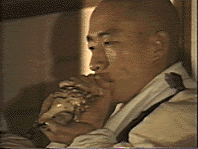 Practicing to blowing shell-horns
Practicing to blowing shell-horns
Cutting hem of straw matts
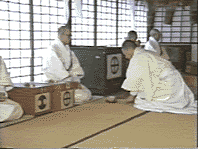 Priests hold a traditional tea ceremony at the end of Bekka. Then they leave Bekka-bo (priestsユ lodging during Bekka period) and ascend to the Nigatsu-do for the main ceremony held there. It indicates that the participants have now gone through the preliminary practice.
Priests hold a traditional tea ceremony at the end of Bekka. Then they leave Bekka-bo (priestsユ lodging during Bekka period) and ascend to the Nigatsu-do for the main ceremony held there. It indicates that the participants have now gone through the preliminary practice.
At 2 o'clock on March 1, old fire is killed. A priest called Dodoji makes new fire with flint and steel and lights the eternal lamp. The lamp is offered to the Kannon-image of Nigatsu-do and is kept burning until the same day of the following year.
March 1-14 -- the main ceremony of Shuni-e
Onakatomi-no-Harai (Rite of Exocism)
The rite of exocism, purification of the participating priests, takes place at twilight of the previous evening of the main ceremony. It is popularly known as "assembling goblins" (Tengu-yose) and aims at pacifying and purifying everyone to make sure the religious austerities be carried through without disturbance.
Jukai (Administering the Precepts)
At about 2 o'clock on March 1, priests go through the ceremony of administering the precepts. A priest called "Kai-wajo" reads slowly the text of the precepts that participants should strictly observe throughout the whole ceremony. Other priests recite it together.
Jikido-saho (Etiquette in the Dining Hall)
Priests are allowd to eat only once a day. Boiled rice, Miso soup and another dish are served. A small portion of meal is left over, which are thrown away for birds and animals.
Kaibyaku-hoyo (Six Observance)
The daily observance is comprised of six ceremonies;
・"Nitchu" at noon
・"Nitimotsu" at sunset
・"Shoya" at the first watch of the night
・"Han-ya" at the second watch of the night
・"Goya" at the third watch of the night
・"Jinjo" at dawn
These six observance are performed from the first to the 15th of March.
Three-time-announcement
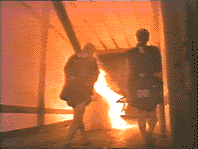 holding a torch attendant-boys run up to Nigatsu-do three times ;
first, to ask the present time,second, to announce that Rengyoshu priests are soon coming up to Nigatsu-do,third, to announce that Rengyoshu now come up.
holding a torch attendant-boys run up to Nigatsu-do three times ;
first, to ask the present time,second, to announce that Rengyoshu priests are soon coming up to Nigatsu-do,third, to announce that Rengyoshu now come up.
10 Big torches are carried up to Nigatsu-do everyday at the observance of the first watch of the night from first to 14th of March. On 12th, eleven instead of ten torches are carried up.
Hashiri no Gyoho (Ritual of Running Circumambulation)
It is said that one single day and night in the celestial world equalls to four hundred years in the human world. This ritual is aimed at catching up to Budda's world by running around Nigatsu-do.
Shushi-saho (Etiquette of cleaning)
Sites of rituals should be kept clean to keep away devils and bad spirits.
Kokannon-shutugo (Appearance of the Small Kannon-image)
The miniature shrine of Kannon-image is carried into the inner sancturary and is placed on the alter.
March 12th -- Omizutori
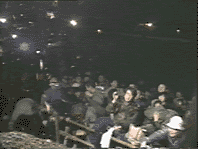 The ceremony of taking sacred water (Omizutori) is practiced at about two o'clock on the 13th of March.
Omizutori has a legend of its origin. Jitchu, the founder of Shuni-eユ, once invited 13,700 gods to attend to his ceremony . The god "Onyu-myojin" of Wakasa district was delayed in coming because he was then fishing in the Onyu River. To compensate for his late arrival, he offered scented water from the Onyu River. Then two cormorants, one black and the other white, took off from a rock and sacred water began springing from that very spot.
Omizutori is a ritual scooping up scented water from Wakasa Well located below the building of Nigatsudo.
The ceremony of taking sacred water (Omizutori) is practiced at about two o'clock on the 13th of March.
Omizutori has a legend of its origin. Jitchu, the founder of Shuni-eユ, once invited 13,700 gods to attend to his ceremony . The god "Onyu-myojin" of Wakasa district was delayed in coming because he was then fishing in the Onyu River. To compensate for his late arrival, he offered scented water from the Onyu River. Then two cormorants, one black and the other white, took off from a rock and sacred water began springing from that very spot.
Omizutori is a ritual scooping up scented water from Wakasa Well located below the building of Nigatsudo.
The sacred water is poured into two pots. One is filled with sacred water taken in all past rituals, which contains water of 1,200 years ago. The other is filled with water of the previous year. A little bit of water from theformer pot is poured into the latter.
Otaimatsu (Ceremony of Big Pine-torch)
Field below Nigatsu-do is packed with standing audience waiting for the exciting ceremony of Otaimatsu. Eleven basket pine-torches are swung by priests and sparks shower over the audience. Shuni-e ceremonies reach climax with the gorgeous "Otaimatsu" and esoteric "Omizutori". The magnificent basket torch speaks for the Omizutori as a great ritual of water and fire.
Preparing these basket pine-torches consumes a great deal of time. Boy-attendants insert cypress greens into a number of cypress rods which have been cut into six inch square pieces and assmbled in the form of flower bouquets. Then thin wooden boards are added to partially cover the cypress and rods so as to resemble a basket
At two o'clock in the morning. Sacred water is spooled up for the eleven-faced Kannon. Not only is it offered to the Kannon, but also is given away topious public, who use it as religious water for the year.
Shuni-e reaches the final stage after more than a month's ceremonies. Priests has been praying for the world peace for 24 days.
At the conclusion of the rite of Omizutori on March 15th, a great number of women come from early morning carrying their children on their backs, to pay homage to Kannon, and to urge the priests to put their Dattan-caps on their children's heads. This custom is believed to assure a happy future for the children.
The religious austerities of Shuni-e are, with this gesuture of mother and children, carried through to completion.
Daibutsu prays for the prosperity of the nation, Eleven-headed Kannon for the happiness of the people. Rengyoshu priests practises these tough exercises to mediate Daibutsu and Kannon.
With the end of Shuni-e brings the lovely Spring cherry blossoms to our Nara.